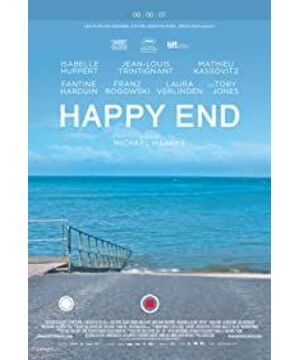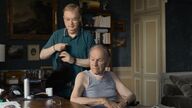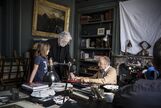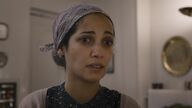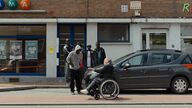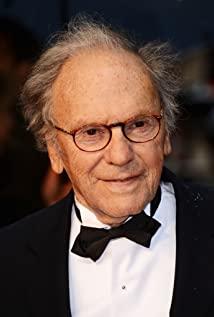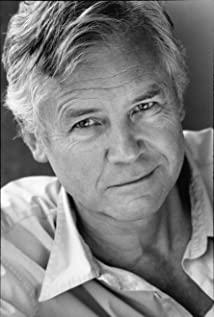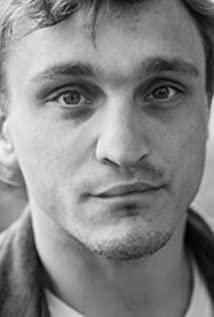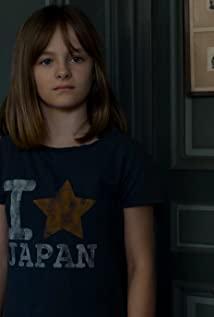wechat ID: cityisland1984
The closer you get to the details of everyday life, the more blurred life becomes. People can also easily become unhappy.
Movies, too. "Movies with too much detail and too much clarity can only be used for mindless consumption by the audience," Michael Haneke said in a conversation with Alexander Kruger . I take it for granted.
For a middle-class intellectual with a background in philosophy like him, it is inevitable that he will have the perspective of God when looking at problems. But didn't Miss Bird and her mother, Miss Marion, also say, We don't have to constantly be entertaining ourselves, do we?
So I settled down and watched Haneke's Happy Ending, hoping to find a way to distance myself from real life.
"Happy Ending" tells the story of a middle-class French family where life looks good for three generations, but everyone is gloomy. There is no conflicting relationship between daggers, but more of a lack of dialogue and a sense of security. Duplicity or stagnant water can destroy people more than the usual contradictory patterns of clamoring.
What left a good impression on me in the film was not the scenery of the Port of Calais and the elegant decoration of the mansion, but Haneke's blankness in details and restraint in expressing emotions. This allows the film to have its own rhythm of thinking, maintaining a dialogue with people outside the film with an open attitude. His technique is so beautiful that I've only picked three of the most typical scenes to try to gain insight into how he does it all.
01. An emotionally stable quarrel Annie, played by Yu Peier, is the eldest daughter in the family, a middle-aged woman, troubled by affairs, troubled, impatient, impatient and gentle towards people, and most of the time she speaks carelessly , it's easy to get bored. Her son Pierre was imprisoned in the family like a beast. He does not have the decency of the middle class, and he does not identify with his own identity. He is the most grumpy one in the family. The construction company run by his grandfather had a safety accident in his own hands, which made him completely feel that he did not match the family. The 21-minute scene is about the identification of responsibility for this safety accident. Because workers were injured and involved in compensation, the staff of the government organization came to investigate the scene. Anne and Pierre, as the main leaders of the company, needed to accompany them to accept the inquiry. As a result, Pierre couldn't stand any words from others at all, and tit for tat quickly turned his face.
There is no change in the scene and camera position in the whole scene, and the scheduling is completed by the actors entering the painting and moving in sequence. Anne mostly faces the camera sideways, and Pierre only has the large back of this black jacket from start to finish. Instead, it was the two passers-by staff who gave the front face. Before and after this, they never showed up again. As one of the protagonists of the quarrel scene, he does not show facial expressions, has almost no body language, and only relies on his back. This is not a moment of "God acting", but Haneke's cold-eyed spectacle. The disorganized dialogue of those chariots gave no clue to clarifying the facts, and was only intended to irritate Pierre and make the fight raging. After the dispute began, Haneke completely suppressed Pierre, without giving him the slightest chance to release. Such a result may be interpreted as the deprivation of his right to speak and the expression of his inner self-confidence in terms of role modeling. But I'm more inclined towards the cinematic aesthetic choices. Keep a distance from overly intense or dramatic scenes, but explain more details, so that the entire film maintains a unified tension in emotional expression.
02. A quiet action scene. Pierre went to reconcile with the injured worker's son. The family lived in the suburbs of Calais, in a densely populated area, very much like a relocated house. When the scene first started, it wasn't even clear what Pierre was doing, and who was opposite him. The two stood deep in the camera, talking lightly as if they were checking the water meter at home. Without warning, the person opposite Pierre knocked him down. The whole process could only hear the sound of the wind, and the ambient sound like the hustle and bustle of your neighborhood at five o'clock in the afternoon.
The intent of this approach is to want us to focus on the story rather than the scene. what happened? rather than what it was like. If the camera is too close, the fight scene will inevitably become one of the highlights of the whole film, and Pierre would be the hero, but he is not. Moreover, this one-shot shot itself is quite humorous. The opening scene swayed from left to right, like the perspective of an uncle walking, watching the stranger pass by without any special destination.
At the end, moving from right to left, getting closer and closer to Pierre who was beaten, that is, the uncle wanted to see, what happened to this person? This wide-angle lens incorporates a lot of background elements, creating a great sense of space, and the distance between the characters, making Pierre's reckless entry into the slums even more isolated and helpless.
03. Grandpa who attempted suicide was discharged home
Laurent's grandfather, 83, suffers from amnesia, and his mobility is deteriorating year by year. A few years ago, he used a pillow to suffocate his wife on the hospital bed with his own hands. This story is only told through grandfather's memories in this film, and there is no specific video part). So when he himself started to go downhill, he started begging for death. One night, he trembled and drove away from a car at home with a cane. When he heard from him again, he was already in the hospital. That night, his son came home from a busy day in the hospital, chatted with his family, and indirectly told his grandfather's car crash into a tree and attempted suicide. As for the scene of hitting the tree and the appearance of the old man, nothing was shown. After a period of time, the old man recovered and was discharged from the hospital. It was supposed to be the part with the most complicated emotions and the most detailed relationship between family members, but was played by a rhubarb.
At the beginning of the show, I was even attracted by the pair of beautiful old walnut doors (which may also be teak) and the emerald canopy reflected on the glass. I also watched for a while at the strong little back of rhubarb and the naughty little butt. But the picture didn't change for a long time, and it was only when a wheelchair appeared in the distance that it seemed to get off, and then turned around and pushed it away, and then realized that the scene was over. How is the old man's mood, has the eldest daughter tried to appease him, and is he willing to respond to the family's excessive concern? If you can ask some questions, the director's purpose will be achieved. The results of interpreting movies are inherently different from person to person, and the 78-year-old Jianghu can't understand this.
"Sometimes I'm surprised people see things in my films that I don't show. But that's a good thing. I try to make films that the audience can understand from a different perspective. Because real life is like that. . Contradictory and ambiguous. Only bad movies are unambiguous. I try to tell stories the way life educates people, which is conflict and contradiction. Reality is always annoying. This is my movie Something to try." The Hollywood Reporter published an interview with Haneke on November 30, 2017, after "Happy Ending" was nominated for an Oscar for Best Foreign Language Film.
View more about Happy End reviews


